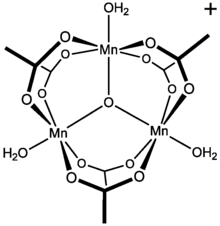Manganese(III) acetate

| |
| Names | |
|---|---|
| IUPAC name
Manganese triacetate
| |
| Other names
Manganese triacetate dihydrate; Manganese(III) acetate dihydrate
| |
| Identifiers | |
| |
3D model (JSmol)
|
|
| ChemSpider | |
| ECHA InfoCard | 100.012.365 |
PubChem CID
|
|
CompTox Dashboard (EPA)
|
|
| |
| |
| Properties | |
| C6H9MnO6•2H2O | |
| Molar mass | 268.13 g/mol (dihydrate) |
| Appearance | Brown powder |
| Density | 1.049 g cm−3, liquid; 1.266 g cm−3, solid |
Except where otherwise noted, data are given for materials in their standard state (at 25 °C [77 °F], 100 kPa).
| |
Manganese(III) acetate is a chemical compound that is used as an oxidizing agent in organic synthesis[1] and materials science.[2] Like the analogous acetates of iron and chromium, it is an oxygen-centered coordination complex containing three manganese atoms bridged by acetate units.[3] The anhydrous form of this compound crystallizes as a linear coordination polymer, with an additional acetic acid molecule bridging between manganese atoms on consecutive three-manganese clusters.[3] The chemical is therefore not a simple metal acetate ionic compound nor does the actual structure of it reflect the simple "Mn(OAc)3" chemical formula that is commonly given. It is usually used as the dihydrate, though the anhydrous form is also used in some situations. The dihydrate is prepared by reacting potassium permanganate and manganese(II) acetate in acetic acid; addition of acetic anhydride to the reaction produces the anhydrous form.[1] It is also synthesized by electrochemical method starting from Mn(OAc)2.[4]
Mangese triacetate has been used as a single electron oxidant. It can oxidize alkenes via addition of acetic acid to form lactones.
This process is thought to proceed via the formation of a •CH2CO2H radical intermediate, which then reacts with the alkene, followed by additional oxidation steps and finally ring closure.[1] When the alkene is not symmetric, the major product depends on the nature of the alkene, and is consistent with initial formation of the more stable radical (among the two carbons of the alkene) followed by ring closure onto the more stable conformation of the intermediate.[5]
When reacted with enones, the carbon on the other side of the carbonyl reacts rather than the alkene portion, leading to α'-acetoxy enones.[6] In this process, the carbon next to the carbonyl is oxidized by the manganese, followed by transfer of acetate from the manganese to it.[7]
It can similarly oxidize β-ketoesters at the α carbon, and this intermediate can react with various other structures, including halides and alkenes (see: manganese-mediated coupling reactions). One extension of this idea is the cyclization of the ketoester portion of the molecule with an alkene elsewhere in the same structure.[8]
References
- ^ a b c Snider, Barry B. (2001). "Manganese(III) Acetate". Encyclopedia of Reagents for Organic Synthesis. Wiley. doi:10.1002/047084289X.rm018.
- ^ "Non-periodic trends in the oxidative dissolution of transition metals by manganese(III) acetate". Inorganica Chimica Acta. 115 (1). 1986. doi:10.1016/S0020-1693(00)87696-3.
{{cite journal}}: Cite uses deprecated parameter|authors=(help) - ^ a b "The crystal structure of "anhydrous manganic acetate"". Recl. Trav. Chim. Pays-Bas. 88: 545–552. 1969. doi:10.1002/recl.19690880505.
{{cite journal}}: Cite uses deprecated parameter|authors=(help) - ^ "Radical Cyclization of Fluorinated 1,3-Dicarbonyl Compounds with Dienes Using Manganese(III) Acetate and Synthesis of Fluoroacylated 4,5-Dihydrofurans". Helv. Chim. Acta. 94 (11): 2027–2038. 2011. doi:10.1002/hlca.201100105.
{{cite journal}}: Cite uses deprecated parameter|authors=(help) - ^ "Manganese(III)-mediated γ-lactone annulation". J. Org. Chem. 50 (1): 10–18. 1985. doi:10.1021/jo00201a003.
{{cite journal}}: Cite uses deprecated parameter|authors=(help) - ^ "Oxidation of enones to α'-acetoxyenones using manganese triacetate". Tetrahedron Letters. 25: 5839–5842. 1984. doi:10.1016/S0040-4039(01)81699-3.
{{cite journal}}: Cite uses deprecated parameter|authors=(help) - ^ "Situselective α'-acetoxylationof some α,β-enones by manganic acetate oxidation". Can. J. Chem. 54 (24): 3830–3832. 1976. doi:10.1139/v76-550.
{{cite journal}}: Cite uses deprecated parameter|authors=(help) - ^ "Mechanism of manganese(III)-based oxidation of β-keto esters". J. Org. Chem. 53: 2137–2141. 1988. doi:10.1021/jo00245a001.
{{cite journal}}: Cite uses deprecated parameter|authors=(help)

